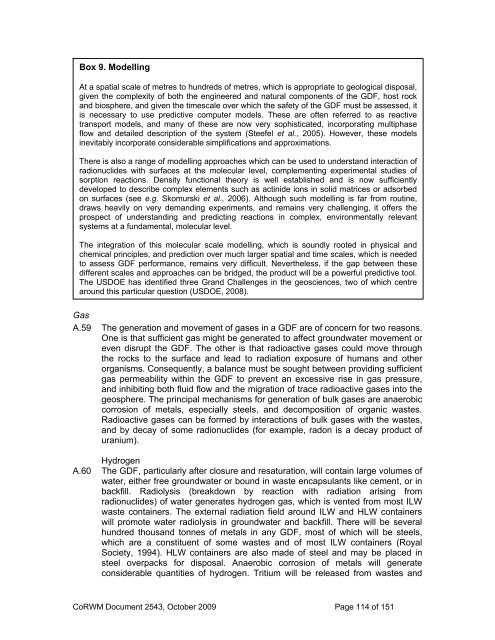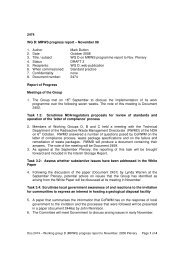2009 Report to Government on National Research and
2009 Report to Government on National Research and
2009 Report to Government on National Research and
- TAGS
- corwm.decc.gov.uk
You also want an ePaper? Increase the reach of your titles
YUMPU automatically turns print PDFs into web optimized ePapers that Google loves.
Box 9. Modelling<br />
At a spatial scale of metres <str<strong>on</strong>g>to</str<strong>on</strong>g> hundreds of metres, which is appropriate <str<strong>on</strong>g>to</str<strong>on</strong>g> geological disposal,<br />
given the complexity of both the engineered <strong>and</strong> natural comp<strong>on</strong>ents of the GDF, host rock<br />
<strong>and</strong> biosphere, <strong>and</strong> given the timescale over which the safety of the GDF must be assessed, it<br />
is necessary <str<strong>on</strong>g>to</str<strong>on</strong>g> use predictive computer models. These are often referred <str<strong>on</strong>g>to</str<strong>on</strong>g> as reactive<br />
transport models, <strong>and</strong> many of these are now very sophisticated, incorporating multiphase<br />
flow <strong>and</strong> detailed descripti<strong>on</strong> of the system (Steefel et al., 2005). However, these models<br />
inevitably incorporate c<strong>on</strong>siderable simplificati<strong>on</strong>s <strong>and</strong> approximati<strong>on</strong>s.<br />
There is also a range of modelling approaches which can be used <str<strong>on</strong>g>to</str<strong>on</strong>g> underst<strong>and</strong> interacti<strong>on</strong> of<br />
radi<strong>on</strong>uclides with surfaces at the molecular level, complementing experimental studies of<br />
sorpti<strong>on</strong> reacti<strong>on</strong>s. Density functi<strong>on</strong>al theory is well established <strong>and</strong> is now sufficiently<br />
developed <str<strong>on</strong>g>to</str<strong>on</strong>g> describe complex elements such as actinide i<strong>on</strong>s in solid matrices or adsorbed<br />
<strong>on</strong> surfaces (see e.g. Skomurski et al., 2006). Although such modelling is far from routine,<br />
draws heavily <strong>on</strong> very dem<strong>and</strong>ing experiments, <strong>and</strong> remains very challenging, it offers the<br />
prospect of underst<strong>and</strong>ing <strong>and</strong> predicting reacti<strong>on</strong>s in complex, envir<strong>on</strong>mentally relevant<br />
systems at a fundamental, molecular level.<br />
The integrati<strong>on</strong> of this molecular scale modelling, which is soundly rooted in physical <strong>and</strong><br />
chemical principles, <strong>and</strong> predicti<strong>on</strong> over much larger spatial <strong>and</strong> time scales, which is needed<br />
<str<strong>on</strong>g>to</str<strong>on</strong>g> assess GDF performance, remains very difficult. Nevertheless, if the gap between these<br />
different scales <strong>and</strong> approaches can be bridged, the product will be a powerful predictive <str<strong>on</strong>g>to</str<strong>on</strong>g>ol.<br />
The USDOE has identified three Gr<strong>and</strong> Challenges in the geosciences, two of which centre<br />
around this particular questi<strong>on</strong> (USDOE, 2008).<br />
Gas<br />
A.59 The generati<strong>on</strong> <strong>and</strong> movement of gases in a GDF are of c<strong>on</strong>cern for two reas<strong>on</strong>s.<br />
One is that sufficient gas might be generated <str<strong>on</strong>g>to</str<strong>on</strong>g> affect groundwater movement or<br />
even disrupt the GDF. The other is that radioactive gases could move through<br />
the rocks <str<strong>on</strong>g>to</str<strong>on</strong>g> the surface <strong>and</strong> lead <str<strong>on</strong>g>to</str<strong>on</strong>g> radiati<strong>on</strong> exposure of humans <strong>and</strong> other<br />
organisms. C<strong>on</strong>sequently, a balance must be sought between providing sufficient<br />
gas permeability within the GDF <str<strong>on</strong>g>to</str<strong>on</strong>g> prevent an excessive rise in gas pressure,<br />
<strong>and</strong> inhibiting both fluid flow <strong>and</strong> the migrati<strong>on</strong> of trace radioactive gases in<str<strong>on</strong>g>to</str<strong>on</strong>g> the<br />
geosphere. The principal mechanisms for generati<strong>on</strong> of bulk gases are anaerobic<br />
corrosi<strong>on</strong> of metals, especially steels, <strong>and</strong> decompositi<strong>on</strong> of organic wastes.<br />
Radioactive gases can be formed by interacti<strong>on</strong>s of bulk gases with the wastes,<br />
<strong>and</strong> by decay of some radi<strong>on</strong>uclides (for example, rad<strong>on</strong> is a decay product of<br />
uranium).<br />
Hydrogen<br />
A.60 The GDF, particularly after closure <strong>and</strong> resaturati<strong>on</strong>, will c<strong>on</strong>tain large volumes of<br />
water, either free groundwater or bound in waste encapsulants like cement, or in<br />
backfill. Radiolysis (breakdown by reacti<strong>on</strong> with radiati<strong>on</strong> arising from<br />
radi<strong>on</strong>uclides) of water generates hydrogen gas, which is vented from most ILW<br />
waste c<strong>on</strong>tainers. The external radiati<strong>on</strong> field around ILW <strong>and</strong> HLW c<strong>on</strong>tainers<br />
will promote water radiolysis in groundwater <strong>and</strong> backfill. There will be several<br />
hundred thous<strong>and</strong> <str<strong>on</strong>g>to</str<strong>on</strong>g>nnes of metals in any GDF, most of which will be steels,<br />
which are a c<strong>on</strong>stituent of some wastes <strong>and</strong> of most ILW c<strong>on</strong>tainers (Royal<br />
Society, 1994). HLW c<strong>on</strong>tainers are also made of steel <strong>and</strong> may be placed in<br />
steel overpacks for disposal. Anaerobic corrosi<strong>on</strong> of metals will generate<br />
c<strong>on</strong>siderable quantities of hydrogen. Tritium will be released from wastes <strong>and</strong><br />
CoRWM Document 2543, Oc<str<strong>on</strong>g>to</str<strong>on</strong>g>ber <str<strong>on</strong>g>2009</str<strong>on</strong>g> Page 114 of 151



